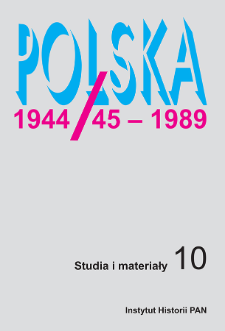- Search in all Repository
- Literature and maps
- Archeology
- Mills database
- Natural sciences
Advanced search
Advanced search
Advanced search
Advanced search
Advanced search

Object
Title: Organizacja opieki nad dziećmi i młodzieżą w latach 1944–1950 – od prób realizacji przedwojennych rozwiązań do przejęcia wzorców radzieckich
Subtitle:
Polska 1944/45-1989 : studia i materiały 10 (2011)
Contributor:
Instytut Historii Polskiej Akademii Nauk
Publisher:
Place of publishing:
Description:
s. 135-154 ; Zawiera tabele. ; Streszcz. ang
Type of object:
Abstract:
A reflection on the functioning of care for children and adolescents in Poland after World War II is far from full in Polish historiography.Although the postulate to centralise social care, coordinate it and increase the state’s participation in it, was put forward as early as 1944, in 1945–1947 political circumstances made it impossible for social care to be subject of endeavours of the communists.In these post-war years, the actual care for children and young people was totally dominated by social organisations. Children and adolescents were placed mainly in 380 children’s homes run by nuns, which made 43% of the total number of children’s homes residents in Poland. The “successes” of the Polish authorities in their first year of rule were limited to the takeover of a few charity organisations that were allowed to exist under the German occupation of Poland: the Central Welfare Council (Polish: Rada Główna Opiekuńcza) and Polish Red Cross (Polski Czerwony Krzyż).The later “competition” of the Polish Socialist Party (Polish acronym: PPS) and Polish People’s Party (PSL), together with what we usually call “civic society” influenced the “minimalism” of political ideas of the Polish Workers’ Party (Polska Partia Robotnicza) about this sphere of social reality, reflected mainly in pushing for the principle to build nurseries and kindergartens and in distribution of founds through the two PPR’s “own” ministries: the Ministry of Industry and Ministry of Supply. The Ministry of Industry, led by a PPR’s strong man, Hilary Minc, together with the Ministry of Supply and Trade, headed by an another PPR member, Jerzy Sztachelski, were the most important tools in the communist realisation of social care modelled on the Soviet examples.When finally the state control became possible (1949–1950), a majority of social organisations (including the charity ones) was suppressed or integrated. Such was the fate of children and adolescents organisations: the Polish YMCA , Central Committee of Social Care (Centralny Komitet Opieki Społecznej), Society of Orphans’ Nests and Kościuszko’s Villages (Towarzystwo Gniazd Sierocych i Wiosek Kościuszkowskich), “Caritas” and tens of smaller ones.
Relation:
Polska 1944/45-1989 : studia i materiały
Volume:
Start page:
End page:
Detailed Resource Type:
Format:
Resource Identifier:
oai:rcin.org.pl:59707 ; 2450-8357
Source:
IH PAN, sygn. B.155/10 Podr. ; IH PAN, sygn. B.156/10 ; click here to follow the link
Language:
Language of abstract:
Rights:
Licencja Creative Commons Uznanie autorstwa-Bez utworów zależnych 4.0
Terms of use:
Zasób chroniony prawem autorskim. [CC BY-ND 4.0 Międzynarodowe] Korzystanie dozwolone zgodnie z licencją Creative Commons Uznanie autorstwa-Bez utworów zależnych 4.0, której pełne postanowienia dostępne są pod adresem: ; -
Digitizing institution:
Instytut Historii Polskiej Akademii Nauk
Original in:
Biblioteka Instytutu Historii PAN
Access:
Object collections:
- Digital Repository of Scientific Institutes > Partners' collections > Institute of History PAS > Serials
- Digital Repository of Scientific Institutes > Partners' collections > Institute of History PAS > Institute Publications
- Digital Repository of Scientific Institutes > Partners' collections > Institute of History PAS > Institute Publications > Journals
- Digital Repository of Scientific Institutes > Partners' collections > Institute of History PAS > Institute Publications > Journals > Polska 1944/45-1989
- Digital Repository of Scientific Institutes > Literature > Journals/Articles
Last modified:
Dec 16, 2020
In our library since:
Sep 21, 2016
Number of object content downloads / hits:
415
All available object's versions:
https://rcin.org.pl./publication/78855
Show description in RDF format:
Show description in RDFa format:
Show description in OAI-PMH format:
Objects Similar
Juźwik, Aleksander
Juźwik, Aleksander
Juźwik, Aleksander
Juźwik, Aleksander
Smosarski, Ludomir
Wolsza, Tadeusz (1956– )
Drukier, Bolesław ( –2006)

 INSTYTUT ARCHEOLOGII I ETNOLOGII POLSKIEJ AKADEMII NAUK
INSTYTUT ARCHEOLOGII I ETNOLOGII POLSKIEJ AKADEMII NAUK
 INSTYTUT BADAŃ LITERACKICH POLSKIEJ AKADEMII NAUK
INSTYTUT BADAŃ LITERACKICH POLSKIEJ AKADEMII NAUK
 INSTYTUT BADAWCZY LEŚNICTWA
INSTYTUT BADAWCZY LEŚNICTWA
 INSTYTUT BIOLOGII DOŚWIADCZALNEJ IM. MARCELEGO NENCKIEGO POLSKIEJ AKADEMII NAUK
INSTYTUT BIOLOGII DOŚWIADCZALNEJ IM. MARCELEGO NENCKIEGO POLSKIEJ AKADEMII NAUK
 INSTYTUT BIOLOGII SSAKÓW POLSKIEJ AKADEMII NAUK
INSTYTUT BIOLOGII SSAKÓW POLSKIEJ AKADEMII NAUK
 INSTYTUT CHEMII FIZYCZNEJ PAN
INSTYTUT CHEMII FIZYCZNEJ PAN
 INSTYTUT CHEMII ORGANICZNEJ PAN
INSTYTUT CHEMII ORGANICZNEJ PAN
 INSTYTUT FILOZOFII I SOCJOLOGII PAN
INSTYTUT FILOZOFII I SOCJOLOGII PAN
 INSTYTUT GEOGRAFII I PRZESTRZENNEGO ZAGOSPODAROWANIA PAN
INSTYTUT GEOGRAFII I PRZESTRZENNEGO ZAGOSPODAROWANIA PAN
 INSTYTUT HISTORII im. TADEUSZA MANTEUFFLA POLSKIEJ AKADEMII NAUK
INSTYTUT HISTORII im. TADEUSZA MANTEUFFLA POLSKIEJ AKADEMII NAUK
 INSTYTUT JĘZYKA POLSKIEGO POLSKIEJ AKADEMII NAUK
INSTYTUT JĘZYKA POLSKIEGO POLSKIEJ AKADEMII NAUK
 INSTYTUT MATEMATYCZNY PAN
INSTYTUT MATEMATYCZNY PAN
 INSTYTUT MEDYCYNY DOŚWIADCZALNEJ I KLINICZNEJ IM.MIROSŁAWA MOSSAKOWSKIEGO POLSKIEJ AKADEMII NAUK
INSTYTUT MEDYCYNY DOŚWIADCZALNEJ I KLINICZNEJ IM.MIROSŁAWA MOSSAKOWSKIEGO POLSKIEJ AKADEMII NAUK
 INSTYTUT PODSTAWOWYCH PROBLEMÓW TECHNIKI PAN
INSTYTUT PODSTAWOWYCH PROBLEMÓW TECHNIKI PAN
 INSTYTUT SLAWISTYKI PAN
INSTYTUT SLAWISTYKI PAN
 SIEĆ BADAWCZA ŁUKASIEWICZ - INSTYTUT TECHNOLOGII MATERIAŁÓW ELEKTRONICZNYCH
SIEĆ BADAWCZA ŁUKASIEWICZ - INSTYTUT TECHNOLOGII MATERIAŁÓW ELEKTRONICZNYCH
 MUZEUM I INSTYTUT ZOOLOGII POLSKIEJ AKADEMII NAUK
MUZEUM I INSTYTUT ZOOLOGII POLSKIEJ AKADEMII NAUK
 INSTYTUT BADAŃ SYSTEMOWYCH PAN
INSTYTUT BADAŃ SYSTEMOWYCH PAN
 INSTYTUT BOTANIKI IM. WŁADYSŁAWA SZAFERA POLSKIEJ AKADEMII NAUK
INSTYTUT BOTANIKI IM. WŁADYSŁAWA SZAFERA POLSKIEJ AKADEMII NAUK


































